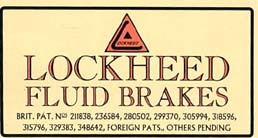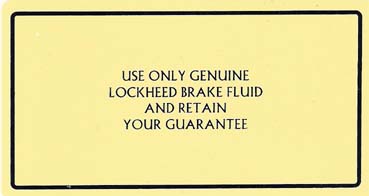
Click on the blue lined pictures to get a large picture
All info from a 1960's catalogue from AP Lockheed. Most partnumbers will be altered by now but may be usefull in searching.

General data for Lockheed parts numbers
Master cylinder exploded view
Master cylinder parts numbers
Wheel cylinder exploded view
Wheel cylinder parts numbers
Front brake hose dimensions
Rear brake hose dimensions (as per original manuel, may be different in practice; more info later)
Some pictures of a N.O.S. genuine brake hose by Frank Graham
Originally VA wheel cylinders do not have a bleeding nipple as we are used to today, but a little bolt which must be taken out before the brass nipple and bleeding tube as on the left picture can be screwed in. In most cases these have been replaced by modern and more practical bleeding nipples.
A genuine factory photo of a brake fluid reservoir
Some hints & tips on brakes:
Essential for good braking action is proper adjustment of the shoes. This goes easiest and most reliable with the later type adjusters fitted to the brake back plates. Earlier cars can be modified. When properly adjusted the shoes are just rubbing the drums.
Always adjust your brake shoes befor you attempt to adjust the handbrake.
Make sure you that the rod operating the master cylinder piston is adjusted so that you have at least 1 mm play before it activates the piston. If its too tight then the small oil return hole in front of the piston is covered by the piston main seal and not all brake fluid can return to the reservoir leading to blocked brakes.
When overhauling brakes use new seals all round flush your pipes with mythalated spirit and switch to silicone brake fluid. This is non hygroscopic and prevents rust and sticky pistons.
The original style transfers for the brake fluid reservoir
as shown on the r.h. top of this page could be supplied
by Gene Wescott
Latest modification for VA brakes:
When relining brakeshoes you will have noticed that the leading front shoes are wearing well and the other shoes are hardly wearing at all. This is caused by the fact that the non leading shoes are not working very hard caused by their design of operation. On later MG's like the post war Magnette and A these shoes were redesigned as twin leading shoes operated by twin cylinders, effectively improving the braking power of the car. Dimension-wise MG-A brakes and MG-VA brakes are equel with same shoe length and width. Using an A type brake back plate you can create a template to modify a VA backplate allowing A type brake cylinders and shoes to be used.
The VA backplate with shoes, cylinder, adjusters, studs and bottem swivel point removed.
Showing the A backplate and the template needed to take the position for the wheelcylinders from the A backplate to the VA backplate
The holes for the A wheelcylinders now marked on the VA backplate
Two stages in the modification proces. On the left hioles for cylinders made, also showing spacers to be made tobe put under the A wheelcylinders. Backplate on the right showing all unwanted holes filled, two A cylinders and spacers fitted and two studs for shoe support made.
The studs are threaded allowing the shoe's height to be adjusted. There are large rings used on the nuts to support the shoes.
The finished product. Note that the springs have moved from the inside to the outside of the shoes. An extra ring and splitpin on the studs keep the shoes in place. Make sure the shoes can move freely around the studs, reshape holes in the shoes if required.
Adjusters now by screw in between cylinder and shoe.
This is how it looks from the back ! Ofcourse you will need new different length brake hoses with proper connections as well.
Carefully drill holes in the drums to reach the brakeshoe adjusters.
Quite a time consuming and carefull job but worth the trouble if done well.